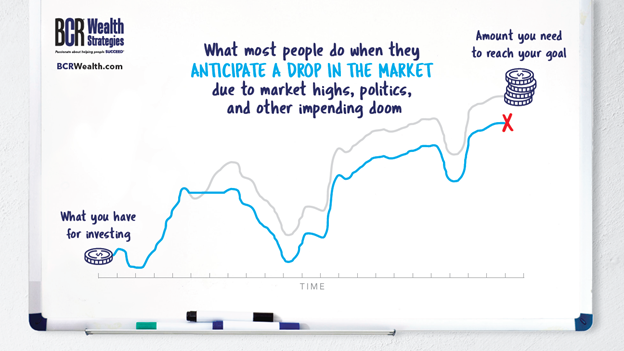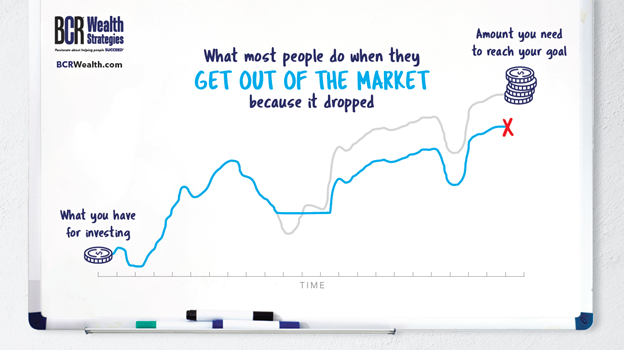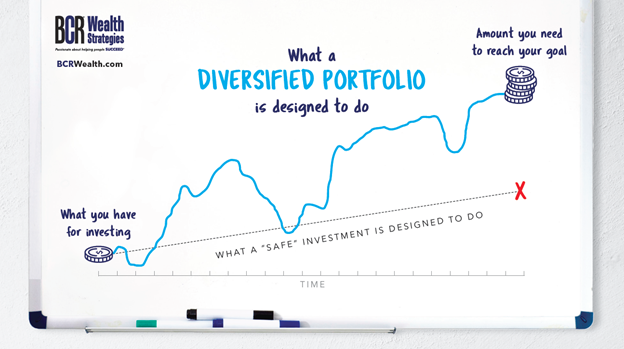
How to prevent yourself from being a part of the horror stories that advisors tell each other
When financial advisors get together at conference and study groups many of the client stories are similar. They go something like this: the market shows volatility, investors panic, they suggest premature selling of securities, advisors’ job is to calm their fear and keep them from creating a loss, but we must watch a few as they inflict financial self-harm, they earn underperforming returns, and they end up off track to meet their targets.
The common conversation is about what we can do to prevent those few clients from making mistakes? Yes, the obvious answer is—well, advise! And so, we do just that to the best of our fiduciary ability. But what about when a client demands we pull the trigger on a move we have seen injure a diversified portfolio time and again?
Typically, this panic-induced buying and selling, or market timing, occurs in one of two scenarios:
- In anticipation of a market drop
- At the bottom of a market drop
Blue Line= The investor falling short of their goals because of market drop anticipation
Gray Line= The market, or what could have been if the investor stayed in their portfolio
**Beware- you are viewing an investor that converted to cash in anticipation for a market drop and got back in after steady market growth. This type of investor will likely fall short of reaching their goals**
This shows an investor that went to cash and got back in after the market continued to grow
Currently, in 2021, this first scenario is of the utmost concern. Analysts say prices are too high, the state of the economy does not justify the markets, and how did we bounce back so fast, anyway? Many feel the markets have been too good for too long and want to get out before things turn potentially bearish.
But what investors here fail to recognize is that markets discover new heights most years. That is quite literally the reason we invest—to take advantage of the long-term gains historically exhibited over time. The prices being paid are what all the willing buyers and sellers agree to exchange at, factoring in where we have been and where the combined opinion expects us to go.
So the “doomsday investor” sells and watches like a deer in headlights as prices continue to drive high. How will they get back in now at a higher price? How much have they sacrificed?
Blue Line= The investor falling short of their goals because they pulled out of the market
Gray Line= The market, or what could have been if the investor stayed in their portfolio
**Beware- you are viewing an investor that went to cash during a market downturn and wanted back in when the market bounced back. This is the classic example of how important it is to ride the lows. This type of investor will likely fall short reaching their goals. **
This shows an investor that went to cash during a downturn and got back in after the market had bounced higher than they got out
The second most injurious market timing scenario generally occurs at the bottom of a market drop. Without fail, in my experience, the bottom of a market drop occurs when the worst headlines are running and the last of the scared investors exit the market. Ironically, this is also when the disciplined advisors and investors are doing the opposite—rebalancing and buying more equities at the reduced price.
As headlines grow worse and worse, investors throw their hands up in the air and insist they would rather risk further potential loss for the gains they could make back in recovery. They argue it is more prudent to be defensive and if “they just get back in at the right time” they will have avoided loss. Unfortunately, this typically happens between 75% and 99% from the bottom and these investors miss their opportunities to get back in time to break even.
In both scenarios, the investor misses out on initial recovery, and oftentimes, some of the market’s best days. They sit on the sidelines until they “feel comfortable” again, which is often past their break-even point, and cause themselves and their portfolios (sometimes irrecoverable) damage. The patient investor, however, would have captured rebound gains and perhaps even exceed their portfolio’s ultimate goal.
Luckily only a small number of clients ask us to do this. Others understand that their portfolio is specifically crafted to handle these types of ups and downs.
Blue Line= The hypothetical market return for a well-diversified portfolio
Gray Line= An investor taking the extra conservative route that left them short of reaching their goals
**Beware- this type of investor is heavily exposed to inflation risk and purchasing power risk. This investor will likely fall short of their goals**
This shows an investor that stayed in a stable investment to prevent losses on paper but lost buying power and did not gain above inflation
However, there is a third scenario I would like to touch on quickly that can be just as injurious as timing the market and that is playing it too safe with your investments. As advisors, we have spent years studying and living through these scenarios and know that there are ways to increase a portfolio’s expected return. Tilting towards certain asset classes, rebalancing, and making high-level manager adjustments are ways to achieve this when we see these opportunities. But when an investor decides to remain too conservative, they risk missing their target, as well.
Let us imagine a new client comes into our firm. After exploring all that is important to them, we determine they need to grow their current investments to a certain amount before their desired retirement date. After some discussion, we recognize that the safe investment that they think they prefer will not get them to the goal.
We agree that a certain amount of risk is needed to achieve the expected return they desire, and that risk appears to match the emotions they can handle when the market goes down or the media causes fear. But, deviating from that plan by trying to time the market or holding too conservative a position can derail that goal or make it impossible altogether, depending on the margin of investor error.
Hopefully, these visuals helped you appreciate why academics and advisors like us suggest that you select your investment philosophy and risk based on your needs and willingness to see it through. Do not let media hype dictate your future. It is almost always a losing game. Instead, lean on your trusted financial advisor to help you make changes as necessary and keep you on track to meet the goals you have expressed.




